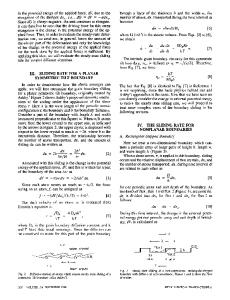Grain boundary grooving by surface diffusion in SrTiO 3 bicrystal
- PDF / 279,031 Bytes
- 6 Pages / 612 x 792 pts (letter) Page_size
- 1 Downloads / 512 Views
MATERIALS RESEARCH
Welcome
Comments
Help
Grain boundary grooving by surface diffusion in SrTiO3 bicrystal Minxian Jin, Eriko Shimada, and Yasuro Ikuma Kanagawa Institute of Technology, Atsugi, Kanagawa, 243-0292, Japan (Received 10 August 1998; accepted 6 November 1998)
High-purity SrTiO3 bicrystal sample (the angle between two [001] directions is 24±) was used in the present experiment to develop a thermal grain boundary groove along the bicrystal grain boundary at different temperatures (1150–1400 ±C) and times (15–6720 min) in air. An atomic force microscope (AFM) was used to observe the surface morphological change in the annealed bicrystal sample in order to measure the width W and depth h of the developed grain boundary groove. It was found that the log W –log t (at 1150–1400 ±C) and the log h –log t (at 1400 ±C) relationships are approximately linear, having slopes of approximately 1y4. Using Mullins’ formulas, the surface diffusion coefficients of SrTiO3 at different temperatures were calculated. Finally, the surface diffusion coefficient determined in the present experiment appears to correspond to the titanium atom, which has the lowest diffusivity in SrTiO3 . I. INTRODUCTION
Transition metal oxides exhibit an extreme range of electronic properties and are commonly found to have a typical perovskite structure. For example, perovskitestructured SrTiO3 is used in semiconductor and superconductor fields.1 However, surface phenomena such as surface diffusion are not well understood in this material. Clarification of the surface diffusion of SrTiO3 is crucial to achieving a better understanding of the properties of this material. Measurement of the surface diffusion coefficient is generally not easy2 ; however, Mullins’ theory on grain boundary grooving allows the surface diffusion coefficient to be measured via grain boundary grooving. Recently, AFM has frequently been used to study surface phenomena, because AFM allows intensive and precise observation of the material surface, and AFM software can be used to analyze any part of the surface morphological structure in three dimensions to provide more information about surface morphological change than other traditional equipment. Ikuma and Taku3 used AFM to study the surface diffusion of MgO bicrystal and Fusamae et al.4 used AFM to study grain boundary grooving in polycrystalline SiC. They measured the width of grain boundary groove and used Mullins’ formula to calculate the surface diffusion coefficients of MgO and SiC, respectively. In the present experiment, we studied grain boundary grooving in SrTiO3 bicrystal at different temperatures and times, and AFM was used to observe surface morphological changes in the SrTiO3 bicrystal after thermal annealing in order to measure the width and depth of grain boundary grooves. Finally, we determined the diffusion coefficients according to Mullins’ formulas. II. EXPERIMENTAL
In the present study, high-purity, finely polished SrTiO3 bicrystal produced by Shinkosha (Tokyo, Japan) 2548
http://journals.cambridge
Data Loading...











